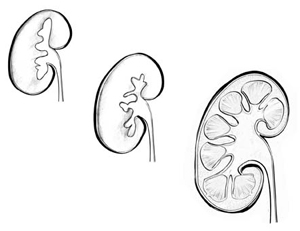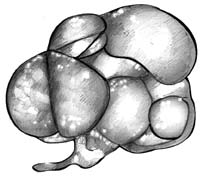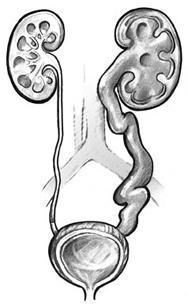

Kidney Dysplasia
On this page:
What is kidney dysplasia?
The kidneys are a pair of bean-shaped organs that filter fluid and wastes from the blood to form urine. Urine flows from the kidneys to the bladder through tubes called ureters. Kidney dysplasia is a condition that can occur in babies while they are growing in the womb. Other terms that health care providers and scientists use to describe this condition are renal dysplasia and multicystic dysplastic kidney (MCDK).
In kidney dysplasia, the internal structures of one or both of the baby’s kidneys do not develop normally. Fluid-filled sacs called cysts replace normal kidney tissue. Kidney dysplasia usually happens in only one kidney. A baby with one working kidney can grow normally and has few, if any, health problems. Babies with kidney dysplasia affecting both kidneys generally do not survive pregnancy, and those who do survive need dialysis and kidney transplant very early in life.
[Top]
How does kidney dysplasia happen?
Ureters are tubes that grow into the kidneys and branch out to form a network of tubules that will collect urine when the fetus is developing in the womb. In kidney dysplasia, the tubules fail to branch out completely. The urine that would normally flow through small tubules has nowhere to go, so it collects inside the affected kidney and forms cysts.

During normal development, the tubules that collect urine branch out throughout the baby’s kidneys.

In kidney dysplasia, the tubules fail to branch out, and urine has nowhere to go. The urine collects inside the kidney and forms cysts.
[Top]
What causes kidney dysplasia?
Kidney dysplasia may be caused by the mother’s exposure to certain drugs or by genetic factors. Pregnant women should talk with their health care providers before taking any medicine during their pregnancy. Drugs that may cause kidney dysplasia include prescription medicines, such as drugs to treat seizures and blood pressure medicines called angiotensin-converting enzyme (ACE) inhibitors and angiotensin receptor blockers (ARBs). A mother’s use of illegal drugs—such as cocaine—can also cause kidney dysplasia in her unborn child.
Kidney dysplasia can also have genetic causes. The disorder appears to be an autosomal dominant trait, which means one parent may pass the trait to a child. When kidney dysplasia is discovered in a child, an ultrasound examination may reveal the condition in one of the parents.
Several genetic syndromes that affect other body systems may include kidney dysplasia as one part of the syndrome. A syndrome is a group of symptoms or conditions that may seem unrelated but are thought to have the same cause—usually a genetic cause. A baby with kidney dysplasia might also have problems of the digestive tract, nervous system, heart and blood vessels, muscles and skeleton, or other parts of the urinary tract.

A baby with kidney dysplasia might have other urinary problems that affect the normal kidney. On the left, urine is blocked from draining out of the kidney. On the right, urine flows backward from the bladder into the ureter and kidney, a condition called reflux.
Problems of the urinary tract that lead to kidney dysplasia might also affect the normal kidney. For example, one urinary birth defect causes blockage at the point where urine normally drains from the kidney into the ureter. Another birth defect causes urine to flow from the bladder back up the ureter, sometimes all the way to the kidney. This condition is called reflux. Over time, if these problems are not corrected, they can damage the one working kidney and lead to total kidney failure.
[Top]
What are the signs or complications of kidney dysplasia?
The affected kidney may be enlarged at birth. Abnormalities in the urinary tract may lead to urinary tract infections. Children with kidney dysplasia may develop high blood pressure, but only rarely. Children with kidney dysplasia may have a slightly increased risk for kidney cancer. Chronic kidney disease and kidney failure may develop if the child has urinary problems that affect the normal kidney. Many children with kidney dysplasia in only one kidney have no signs or symptoms.
[Top]
How is kidney dysplasia diagnosed?
Kidney dysplasia is often found during a fetal ultrasound, also called a sonogram, during pregnancy. Fetal ultrasound uses sound waves to create images of the baby growing in the womb. However, the condition is not always detected before the baby is born. After birth, an enlarged kidney may be detected during an examination for a urinary tract infection or other medical condition.
[Top]
How is kidney dysplasia treated?
If the condition is limited to one kidney and the child has no symptoms, no treatment may be necessary. Regular checkups should include blood pressure measurements, blood tests to measure kidney function, and urine testing for protein. Usually the child is monitored with periodic ultrasounds to look at the affected kidney and to make sure the other kidney continues to grow normally and doesn’t develop any other problems. Children with urinary tract infections may need to take antibiotics.
Removal of the kidney should be considered only if the kidney
- causes pain
- causes high blood pressure
- shows abnormal changes on ultrasound
[Top]
What is the long-term outlook for a child with kidney dysplasia?
Many children with kidney dysplasia in only one kidney grow into healthy adults without any problems. The dysplastic kidney may shrink as the child grows. By age 5, the kidney may no longer be visible in x-ray or ultrasound examinations. Children and adults with only one working kidney should have regular checkups for high blood pressure and kidney damage. A child with urinary problems that lead to kidney failure may eventually need a kidney transplant or blood-cleaning treatments called dialysis.
[Top]
Questions to Ask the Doctor
- Does my child have any other problems in the urinary tract?
- Does my child need to take antibiotics to prevent urinary tract infections?
- Will my child need special medical care?
- How often should my child be checked for high blood pressure and kidney damage?
- How often should the dysplastic kidney and the normal kidney be evaluated by ultrasound?
[Top]
Points to Remember
- Kidney dysplasia is a condition that happens while a baby is growing in the womb.
- Kidney dysplasia usually affects only one kidney, making it unable to function.
- Many people lead healthy, normal lives with only one functioning kidney.
- A child with kidney dysplasia affecting both kidneys may not survive outside the womb. If the child does survive birth, early dialysis and kidney transplant will be needed.
- The mother’s exposure to certain drugs may cause kidney dysplasia in her unborn baby.
- Kidney dysplasia may have genetic causes and is often part of several genetic syndromes that affect other body systems.
- Children and adults with only one working kidney should have regular checkups for high blood pressure and kidney damage.
- Children with urinary problems in the normal, or nondysplastic, kidney that lead to kidney failure will need a kidney transplant or blood-cleaning treatments called dialysis.
[Top]
Hope through Research
Researchers from universities and Government agencies are working to understand the causes of kidney and urinary tract birth defects and to find more effective treatments. Through its Pediatric Urology Program, the National Institute of Diabetes and Digestive and Kidney Diseases funds research into bladder and urinary tract development. Additionally, the Eunice Kennedy Shriver National Institute of Child Health and Human Development has established the Birth Defects Initiative to study the underlying causes of birth defects.
[Top]
For More Information
American Society of Pediatric Nephrology
3400 Research Forest Drive, Suite B7
The Woodlands, TX 77381
Phone: 281–419–0052
Fax: 281–419–0082
Email: info@aspneph.com
Internet: www.aspneph.com
American Urological Association Foundation
1000 Corporate Boulevard
Linthicum, MD 21090
Phone: 1–866–RING–AUA (746–4282) or 410–689–3700
Fax: 410–689–3800
Email: patienteducation@auafoundation.org
Internet: www.auafoundation.org
www.UrologyHealth.org
March of Dimes
1275 Mamaroneck Avenue
White Plains, NY 10605
Phone: 914–997–4488
Email: askus@marchofdimes.com
Internet: www.marchofdimes.com
Eunice Kennedy Shriver National Institute of Child Health and Human Development Information Resource Center
P.O. Box 3006
Rockville, MD 20847
Phone: 1–800–370–2943
Fax: 301–984–1473
Email: NICHDInformationResourceCenter@mail.nih.gov
Internet: www.nichd.nih.gov
The National Kidney and Urologic Diseases Information Clearinghouse collects resource information about kidney diseases for the NIDDK Reference Collection. This database provides titles, abstracts, and availability information for health information and health education resources.
You may view the results of the automatic search on kidney dysplasia. If you wish to perform your own search of the database, go to NIDDK Reference Collection.
This publication may contain information about medications. When prepared, this publication included the most current information available. For updates or for questions about any medications, contact the U.S. Food and Drug Administration toll-free at 1–888–INFO–FDA (463–6332) or visit www.fda.gov. Consult your doctor for more information.
[Top]
National Kidney and Urologic Diseases Information Clearinghouse
3 Information Way
Bethesda, MD 20892–3580
Phone: 1–800–891–5390
TTY: 1–866–569–1162
Fax: 703–738–4929
Email: nkudic@info.niddk.nih.gov
Internet: www.kidney.niddk.nih.gov
The National Kidney and Urologic Diseases Information Clearinghouse (NKUDIC) is a service of the National Institute of Diabetes and Digestive and Kidney Diseases (NIDDK). The NIDDK is part of the National Institutes of Health of the U.S. Department of Health and Human Services. Established in 1987, the Clearinghouse provides information about diseases of the kidneys and urologic system to people with kidney and urologic disorders and to their families, health care professionals, and the public. The NKUDIC answers inquiries, develops and distributes publications, and works closely with professional and patient organizations and Government agencies to coordinate resources about kidney and urologic diseases.
Publications produced by the Clearinghouse are carefully reviewed by both NIDDK scientists and outside experts. This fact sheet was reviewed by the following members of the American Society of Pediatric Nephrology Clinical Affairs Committee: Deepa Chand, M.D.; Maria Ferris, M.D.; Joseph Flynn, M.D.; Keith Lau, M.D.; Tej Mattoo, M.D.; Asha Mougdil, M.D.; and Robert Weiss, M.D.
This publication is not copyrighted. The Clearinghouse encourages users of this publication to duplicate and distribute as many copies as desired.
NIH Publication No. 08–6291
June 2008
[Top]
|






